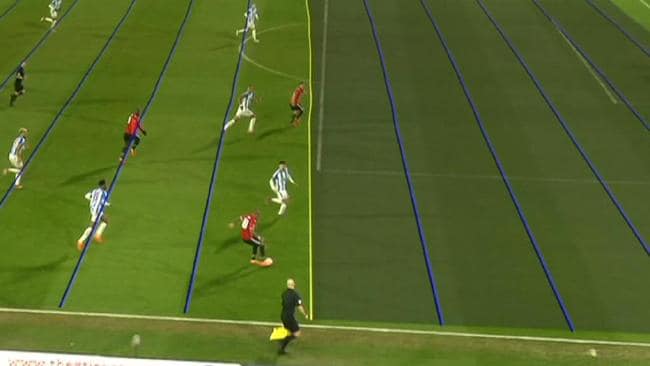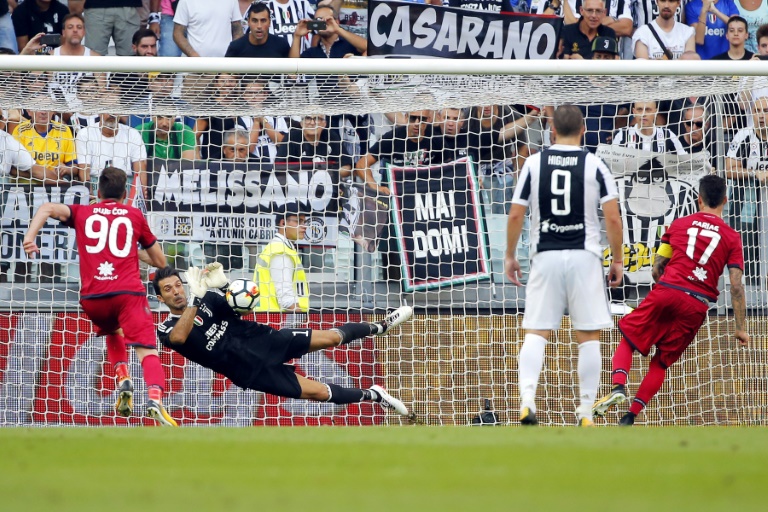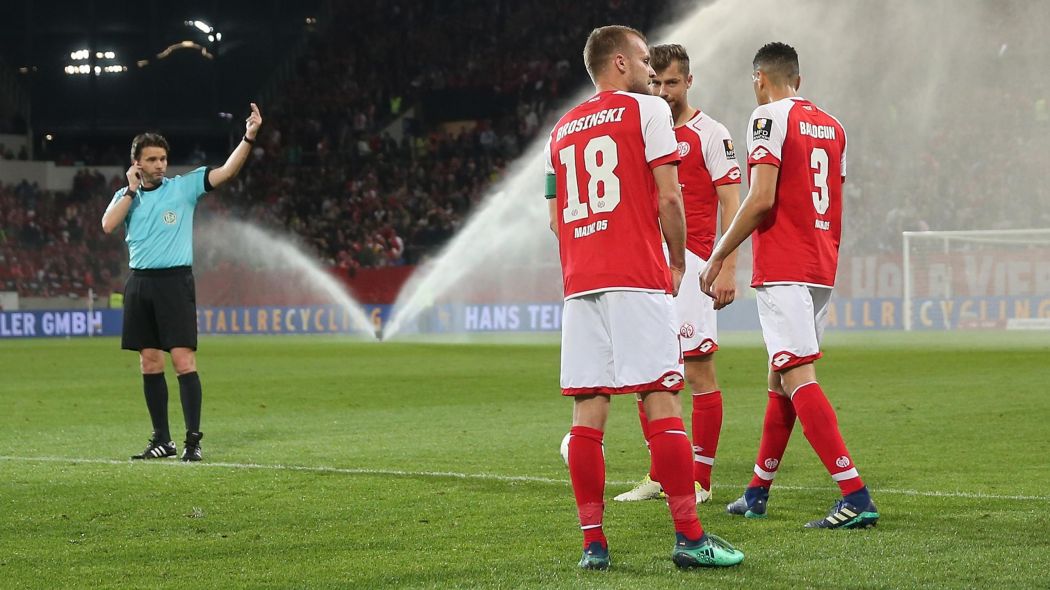Last week, Premier League clubs voted against the introduction of Video Assistant Referees to the league, instead preferring to observe another season of the system being used in the domestic cup competitions in order to make an educated decision as to whether to implement VAR in the future. With the new technology coming under severe criticism at home and abroad in its first season, what does the future hold for VAR, and will the football world ever really embrace it?
“I am extremely happy with VAR so far. We have seen how video assistance has helped referees to make the correct decisions. This is what VAR is all about.” FIFA president Gianni Infantino’s statement after the 2017 Confederations Cup, which saw Video Assistant Referees used on a global stage for the first time, suggested that the new technology was here to stay. The football federations in Italy and Germany had agreed to implement the system on a trial basis in their domestic leagues for the 2017/18 season, while the English FA would use it in one game per round in the FA Cup before deciding whether to introduce it to the Premier League. During the World Cup dress rehearsal last summer, VAR was involved in overturning six “game-changing” decisions, which FIFA pointed to as evidence that the initial trial had been a success. Head of the FIFA Referee’s Committee, Pierluigi Collina, also offered anecdotal evidence from the men in the middle at the tournament that VAR had offered a positive impact on the games. “One of the referees appointed to the Confederations Cup text me after one of the matches and he said he was enjoying the matches because he felt less pressure”, said the eye-bulging Italian. Though it’s use wasn’t universally popular, with supporters in the stadiums offering the opinion that the stoppages in games to allow for decisions ruined the spectacle, and also left those in the stands unsure of what was going on. The technology has clearly created factions within the game.
The use of Video Assistant Referees was approved by the International Football Association Board at their Annual General Meeting in 2016, whereby on-field referees could consult a remote assistant, watching a televised feed of the game with access to replays, in order to make accurate decisions.The initial tests were carried out on an ad-hoc basis, with a Major League Soccer reserve game becoming the first match to use the system in August of that year. A friendly between France and Italy a month later became the first international fixture to use VAR, and by the end of the 2016/17 season Australia’s A-League had signed up to trial the technology. First impressions were good – the Video Assistant had been used to overturn incorrect decisions, and so far hadn’t proven too intrusive on the spectacle of the game. During those initial stages, referee’s had stuck steadfast to IFAB’s mission statement surrounding VAR: the aim is not to achieve 100% accuracy for all decisions, but to eradicate clear and obvious errors. With the initial two year trial period for the project swiftly reaching its end before the board makes a final decision on implementing it worldwide however, the interpretation of that mission statement still varies from referee to referee.

English football received its first taste of VAR in this season’s FA Cup, though it remained unused during its debut in the third round FA Cup match between Brighton and Hove Albion and Crystal Palace. Its first appearance in a game was during the Leicester City vs Fleetwood Town third round replay, where a decision to rule out Kelechi Iheanacho’s goal for offside was overturned by referee Jon Moss after consulting the video assistant. Though despite the decision being correct, and the process taking a little over a minute, Moss was still criticised for carrying out the process incorrectly, having made the signal for VAR – an invisible television – after the decision had been made, rather than before. Oh, what simpler times they were. It wasn’t until the fourth round that VARs impact on the game was truly felt, in a frankly farcical game between Liverpool and West Bromwich Albion at Anfield. The antics began in the 20th minute, when West Brom’s Craig Dawson had a goal ruled out as teammate Gareth Barry was adjudged to have been interfering with play from an offside position, though referee Craig Pawson initially gave the goal, and then stopped play to check with the video assistant. Two minutes later, Pawson was down by the dugouts consulting a video monitor in order to investigate a challenge by Jake Livermore on Mohamed Salah. Having initially waved away the penalty appeals, Salah’s vociferous protests were enough to convince Pawson to take a second look and, after a three minute stoppage, Liverpool were awarded a penalty. Then, at the end of a VAR dominated first half, Pawson was caught in two minds as to whether he should award West Brom’s third goal, and after a further two minute stoppage he finally decided that the goal would stand. There was a further stoppage in the second half to check an offside decision, though the outcome did not affect the scoreline either way. Though it may have been an extreme case, this match in particular sticks in the mind as the moment VAR began to lose its backing in England. West Brom manager Alan Pardew called the system bizarre after the match, claiming that it was a direct cause of two of his players coming off with hamstring strains, after lengthy stoppages allowed their muscles to cool down. Fans at the stadium were left perplexed during the decision process, and pundits afterwards praised the decisions but questioned the process. Still the inadequacies of the system rumbled on. In the fifth round, during the Huddersfield Town v Manchester United tie, a still from the video assistant referee’s footage was shared during the live coverage, and appeared to show that the virtual lines used for offside calls weren’t even in line with the pitch, though Hawk-eye, the company that produce the software for VAR, later claimed that the image broadcast by the BBC had been rendered incorrectly, and the video assistant referee did in fact have access to an accurate version which allowed him to call Juan Mata offside and deny Manchester United a goal. In the fifth round replay between Tottenham Hotspur and Rochdale, on a freezing night at Wembley, VAR stole the headlines once again. In just the sixth minute, Erik Lamela had a goal ruled out after Fernando Llorente was adjudged to have fouled a Rochdale defender in the build-up – several replays later fans and pundits alike were erring towards the opinion that it was Llorente himself who had been fouled. A further stoppage followed when referee Paul Tierney awarded a free-kick, only for his video assistant to overrule the man in the middle and award a penalty. Spurs ended up running out 6-1 winners, but those that had braved the weather to watch the game made their feelings for VAR known, with a chorus of boos greeting each stoppage. With the evidence available it’s no wonder the Premier League are reluctant to introduce VAR in its current guise – though Arsene Wenger added his voice to the minority last weekend, suggesting that with VAR in place Arsenal would have been awarded a penalty at Newcastle.

But what of those leagues that have committed to using video assistants this season? Of the top five leagues in Europe, only Serie A and the Bundesliga have taken the technology on full time, and its fair to say that the reception has been mixed. Within 40 minutes of the opening day fixtures in Serie A, VAR had taken centre stage in the most dramatic of ways. Champions Juventus were its first victims, as referee Fabio Maresca awarded visitors Cagliari a penalty for a foul by Alex Sandro having initially signaled for a corner kick. In the event Cagliari missed the penalty and Juve ran out comfortable winners, but already the new technology was at the forefront of discussion. On the same day, decisions at Verona, Sampdoria and Fiorentina were all made using VAR, though the most controversial moment came at Bologna, where referee Davide Massa incorrectly ruled a Torino goal offside, but blew the whistle before the ball went dead, meaning it was too soon for the incident to be replayed. And you thought VAR was supposed to atone for human error. Between the opening day and January, 309 key incidents were reviewed through VAR, with an overwhelming 93% supporting the referee’s initial decision – a figure that speaks volumes about the standard of refereeing in Italy. In the opening weeks of the Serie A season, the overwhelming sense was that the use of video assistants was extending matches beyond sustainability. With several games ending up with seven plus minutes of stoppage time Juventus manager Max Allegri and captain Gigi Buffon both shared their skepticism, with the former suggesting that the new addition was turning the game into baseball, while the latter said it made football feel robotic. According to Italian Football expert James Horncastle, however, the statistics suggest that VAR is having a positive effect however, with improved discipline compared to last season showing fewer fouls and fewer cards, and up to three refereeing mistakes were being avoided every match. Interestingly, just a fortnight after penning his piece on the success story of VAR in Serie A for ESPN, Horncastle presented the case for the luddite, as controversy raged in Italy over big team bias. Bologna manager Roberto Donadoni was incensed that a handball in the area from Napoli’s Kalidou Koulibaly escaped review from the referee, this coming a couple of weeks after Juventus scored a controversial winner at Cagliari, with the hosts claiming that Medhi Benatia had commited a foul in the build-up to the goal. These incidents led to Italian pundits suggesting that committing to VAR was bad for the game, with Massimo Mauro saying “Let’s get rid of it and go back to where we were before when it was much better.” However in a mid-season meeting between Serie A’s managers and referees, it was agreed that the VAR experiment should continue, with even ardent critics such as Lazio manager Simone Inzaghi conceding that the data which suggested the technology was improving the game had to be trusted. The issues faced in Italy appear to differ from those in England, with the average time to confirm a decision standing at around 29 seconds meaning that those extended stoppages seen in the FA Cup are less of a problem. In a direct contradiction to the English referees lacking conviction, Italian refs appear less likely to check the replay of their decision, something which, given the statistics surrounding refereeing competency in Serie A, is no surprise.

The Bundesliga’s experiment with video assistant referees too, has experienced peaks and troughs. Much like in Serie A, the conversation surrounding the action on the opening day of the season in Germany centered on VAR, with the immediate impression being that its introduction could markedly improve the game. Once again there was a key decision in a high-profile opening day fixture, though this time champions Bayern Munich were the beneficiaries, as Charles Aranguiz’s foul on Robert Lewandowski was picked up by the technology, leading to a penalty award which gave Bayern a 3-0 lead against Bayer Leverkusen. The VAR was used 12 times in that match alone, and afterwards the DFB’s head of refereeing Helmut Krug was quick to sing the praises of the league’s new addition. “We’re delighted with how things went in this opening match. The communication between the referee and the video assistant was flawless. We reached quick and precise decisions in the relevant incidents and our intense preparation work has paid off. Now we want to latch onto this positive start.” Krug was slightly less impressed when, a couple of months later, he was accused of using the technology in order to influence results. Pundits and supporters had noticed the use of VAR becoming more frequent during matches, and it was revealed that video assistant referees had been instructed to challenge any decision they felt the on-field referee had made incorrectly, rather than sticking to the IFABs mission statement that focused on goals, penalties, red cards and mistaken identity. The Bundesliga clubs themselves weren’t made aware of this change in policy until the 25th October, and subsequently the authority of referees was called into question. Furthermore, German newspaper Bild then revealed allegations of match-fixing levelled at Krug who had overseen the video assistant refereeing of Schalke’s 1-1 draw with Wolfsburg in a game that saw the hosts awarded two dubious penalties thanks to VAR. Krug, it just so happens, is a known Schalke supporter. These allegations led to Krug being replaced by fellow former referee Lutz Michael Froehlich as Head of VAR, but there had already been a raft of incidents in the first half of the season that had left fans, players and coaches wondering whether the system could really work. The winter break gave the DFB an opportunity to review VARs success in the first half of the season, and the results showed that, like in Italy, the time taken to review decisions was minimal – roughly 30 seconds on average. Alarmingly, however, the data discovered that 22% of decisions overturned due to video assistant intervention were in fact incorrect. Whilst supporters of the technology will point to the remaining 78%, surely the whole premise of using VAR is to ensure the correct decision is reached? A seminar for Bundesliga referees held during the winter break came to the same conclusion, and returned a level of autonomy to referees by suggesting VAR is not used to finalise decisions in which there is reasonable doubt – arguably making the whole use of it redundant. Still, the Bundesliga has ploughed on with the technology into the second half of the season, and on Monday the experiment reached its farcical nadir. On the stroke of half-time in the match between Mainz and Freiburg, the hosts claimed that defender Marc-Oliver Kempf had handled the ball. Referee Guido Winkmann blew up for half-time, and the players left the field, only for the video assistant to review the footage and overturn the referee’s decision, leaving Winkmann to call the players back from the tunnel in order for Mainz to take the penalty. Ludicrous.
Of course there are plenty of those banging the drum on both sides of the fence. In essence, video assistant referees are a positive, progressive step. Theoretically they reward skill and endeavor, ensuring that teams are not cheated of the correct result by nefarious means or intimidated referees, and they could prevent basic human errors, much in the way goal-line technology has. Unlike goal-line technology, however, the experiment so far has seen VAR take centre stage, which in an of itself is ruining the game. When referees are using the technology as a crutch in order to step back from their sole responsibility, it can only damage the standards of refereeing. When supporters are unaware of what is happening on the pitch, and are unable to lose themselves in the joy and drama of the game, it can only damage the atmosphere inside stadiums. Ultimately, that leads to the game become sterile and devoid of emotion. Furthermore, if the trials in Italy and Germany have taught us anything, its that VAR is not a failsafe alternative to competent refereeing. After all, the assistants are humans too, and in some cases even the keenest eye is unable to call the most marginal decisions. And what’s to stop corruption infiltrating those assistants situated remotely?
Ultimately, it seems the future of VAR hangs in the balance. While the Premier League have declined its use next season, and UEFA are resisting trialing it in the Champions League, La Liga and Ligue 1 will both introduce the system next season, meaning four of Europe’s top five leagues will have video assistants. Perhaps the defining period for this technology will take place over the summer, as FIFA lay the most prized tournament in football at the mercy of VAR. The World Cup could make or break the technology, with the possibility of the most highly anticipated month of football ruined by stoppages, bad calls, and even the threat of corruption. If Russia and Saudi Arabia get called out of the dressing room after the full-time whistle to play out a penalty kick for the hosts, we might just see a few more people jump on the luddite bandwagon.